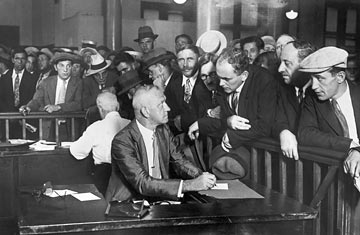
A Great Depression–era employment agency is crowded with men seeking work
(2 of 2)
"We consider it an unqualified success," Bredesen tells TIME, speaking about the 338 jobs created by the pilot program. "I wanted to do more than show concern. These are people with real obligations and, while I support clean energy [the thrust of much of the stimulus], people have to make car payments next month. I'd love to have a great deal more stimulus money to do this type of thing in other counties, but there is not a lot of money available. If there is another stimulus package, real consideration should be given to direct employment, in WPA fashion, in the public and private sector."
The WPA — the largest New Deal program, employing 8.5 million people and spending $11 billion on public projects nationwide — was a real jobs program. More than 80% of its budget was dedicated to labor. In a speech at LSU in 1936, the WPA's legendary head, Harry Hopkins, gave a cogent synopsis of his agency's deep effect on the nation. "You can start out from Baton Rouge in any direction and pass through town after town which has water facilities or sewer facilities or roads or streets or sidewalks or better public buildings, which it would not have had but for the Works Progress Administration."
"In the New Deal, they did everything they could think of to get people paychecks," says Alice Rivlin, a Brookings Institution scholar and former head of the Office of Management and Budget. "For example, there were WPA projects for artists and writers. In the 1970s, we put people to work during recessions doing useful things. These were mostly lower-skills jobs such as teaching assistants, home health-care workers and cleaning up parks. A similar program today could help a great deal with the high level of unemployment among young people."
Shierholz says policymakers should begin thinking about a second stimulus package focused on a jobs program. "If we passed a $200 billion jobs bill, that could create roughly 4 million jobs paying between $40,000 and $50,000," she says. "Four million temporary public sector jobs, for a year or two in duration, would bridge the employment gap while the economy recovers." Voting against the $787 billion measure, GOP Senator Lindsey Graham of South Carolina said, "There are so many things in the package completely unrelated to creating a job in the next 18 months." Only 11% of stimulus money was targeted toward infrastructure, and less than 10% of the jobs created have been public sector jobs.
There are those who caution against a jobs program. Heritage Foundation scholar Brian Riedl is skeptical about the benefit. "Every dollar that Congress injects into the economy must be first taxed or borrowed out of the economy," says Riedl. "The jobs we create in one county come at the cost of jobs in another county. It is a zero-sum game." Riedl believes there are times when government action is called for on humanitarian reasons. But in terms of economic growth, he says, "the only government spending that creates a net bonus for the economy is spending that results in gains for long-term productivity."
Nevertheless, two weeks ago, White House economic adviser Christina Romer signaled that the Administration would consider a new stimulus measure if it did not see strong results from the current package. Prominent economists like Joseph Stiglitz say more stimulus is necessary to drive the economy forward. A jobs program focused on the nation's hardest-hit regions could have an impact. Nationally, 1 in 5 construction workers are unemployed. According to the American Society of Civil Engineers, the nation has $1.5 trillion in unaddressed infrastructure needs. "Clearly there are projects that need to be done," says Shierholz.
